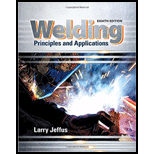
Bundle: Welding: Principles and Applications, 8th + MindTap Welding, 4 terms (24 months) Printed Access Card
8th Edition
ISBN: 9781337219426
Author: Larry Jeffus
Publisher: Cengage Learning
expand_more
expand_more
format_list_bulleted
Textbook Question
Chapter 6, Problem 6R
If the key hole becomes smaller and smaller, what can be done to increase the molten weld pool size and maintain the key hole?
Expert Solution & Answer
Want to see the full answer?
Check out a sample textbook solution
Students have asked these similar questions
問題1
Facilities planning activities include...
product design
facility layout design
process design
all of the above
16.1. The cart has mass M and is filled with water that has a mass mo. If a pump ejects water
through a nozzle having a cross-sectional area A at a constant rate of vo relative to the cart,
determine the velocity of the cart as a function of time. What is the maximum speed
developed by the cart assuming all the water can be pumped out? Assume the frictional
resistance to forward motion is F and the density of water is p.
16.2 A block of mass 10 kg is subjected to a force F(t) at an angle 30° from the horizontal that is
at a constant 12 N for 3 seconds and is suddenly increased to 18 N afterwards. A constant 1 N force
acts on the block as shown as well. The static and kinetic friction coefficients between the block
and the ground is 0.15 and 0.10, respectively. Determine the magnitude and direction of the
velocity of the block after 5 seconds.
Ms=0.15
Mk = 0.10
F(t) [N]
F(t)
18
1 N
30°
m = 10 kg
12
t [s]
3
Chapter 6 Solutions
Bundle: Welding: Principles and Applications, 8th + MindTap Welding, 4 terms (24 months) Printed Access Card
Ch. 6 - What is the first weld bead of a multiple pass...Ch. 6 - What is the purpose of using ceramic backup tapes...Ch. 6 - How can discontinuities in the root face be...Ch. 6 - Describe the motion of the electrode in keyhole...Ch. 6 - What is the purpose of placing an assembled test...Ch. 6 - If the key hole becomes smaller and smaller, what...Ch. 6 - What is the purpose of a hot pass?Ch. 6 - What are the best ways to remove slag between...Ch. 6 - What is the last weld bead on a multipass weld...Ch. 6 - What is the purpose of grooving a joint before...
Ch. 6 - After a weld is back gouged and a groove is...Ch. 6 - When stopping an SMA welding bead on a pipe, what...Ch. 6 - What is the purpose of preheating metal before it...Ch. 6 - What is the purpose of postheating the metal after...Ch. 6 - What is interpass temperature?Ch. 6 - The AWS Visual Inspection Criteria allows one...Ch. 6 - What is the difference between a transverse face...Ch. 6 - What changes can be made to successfully make a...
Knowledge Booster
Learn more about
Need a deep-dive on the concept behind this application? Look no further. Learn more about this topic, mechanical-engineering and related others by exploring similar questions and additional content below.Similar questions
- I need expert handwritten solutions, don't use Artificial intelligencearrow_forwardI need expert handwritten solutions, don't use Artificial intelligencearrow_forwardConsider the combined gas-steam power cycle. The topping cycle is a gas-turbine cycle that has a pressure ratio of 8. Air enters the compressor at 300 K and the turbine at 1300 K. The isentropic efficiency of the compressor is 80%, and that of the gas turbine is 85%. The bottoming cycle is a simple Rankine cycle operating between the pressure limits of 7 MPa and 5 kPa. Steam is heated in a heat exchanger by the exhaust gases to a temperature of 500°C and the isentropic efficiency of the turbine is 90 %. The exhaust gases leave the heat exchanger at 450 K. Considering the mass flow rate steam as 1 kg/s, determine: A) Net power, B) Total input heat, C) Total entropy generation, D) Energy efficiency, E) Exergy efficiency, F) T-s diagram Solve by EES Compressor Air -③ in Exhaust gases Pump Combustion chamber Gas turbine Gas cycle Heat exchanger Condenser Steam Steam turbine cyclearrow_forward
- I need expert solution s to this question, don't use Artificial intelligencearrow_forwardI need solutions to this questions Don't use Artificial intelligencearrow_forwardPlease consider the following closed-loop Multiple-Input Multiple-Output (MIMO) control system: R₁(s) and R2(s) are the reference signals (or inputs), • G₁(s) (where i = 1,2,3,4,5) are the plant transfer functions, • C₁(s) and C2(s) are the responses (or system outputs), • All of them are in Laplace domain. R2 + R₁ + + G₂(s) G3(S) Tasks: G5(s) G4(s) + G₁(s) می a) Please derive the transfer function between C₁ (s) and R₂(s) (i.e., find R₂(s) (10 marks) (10 marks) b) Please derive the transfer function between C₂(s) and R₁(s) (i.e., find C2 (s)). R₁(s) Hint: Please carefully analyse how the signals interact with the plants G₁(s) and find all paths fromarrow_forward
arrow_back_ios
SEE MORE QUESTIONS
arrow_forward_ios
Recommended textbooks for you
 Welding: Principles and Applications (MindTap Cou...Mechanical EngineeringISBN:9781305494695Author:Larry JeffusPublisher:Cengage Learning
Welding: Principles and Applications (MindTap Cou...Mechanical EngineeringISBN:9781305494695Author:Larry JeffusPublisher:Cengage Learning

Welding: Principles and Applications (MindTap Cou...
Mechanical Engineering
ISBN:9781305494695
Author:Larry Jeffus
Publisher:Cengage Learning
Differences between Temporary Joining and Permanent Joining.; Author: Academic Gain Tutorials;https://www.youtube.com/watch?v=PTr8QZhgXyg;License: Standard Youtube License